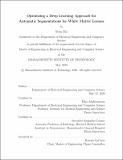| dc.contributor.advisor | Elfar Adalsteinsson and Jayashree Kalpathy-Cramer. | en_US |
| dc.contributor.author | Ko, Sean,M. Eng.Massachusetts Institute of Technology. | en_US |
| dc.contributor.other | Massachusetts Institute of Technology. Department of Electrical Engineering and Computer Science. | en_US |
| dc.date.accessioned | 2020-09-15T21:56:50Z | |
| dc.date.available | 2020-09-15T21:56:50Z | |
| dc.date.copyright | 2020 | en_US |
| dc.date.issued | 2020 | en_US |
| dc.identifier.uri | https://hdl.handle.net/1721.1/127418 | |
| dc.description | Thesis: M. Eng., Massachusetts Institute of Technology, Department of Electrical Engineering and Computer Science, May, 2020 | en_US |
| dc.description | Cataloged from the official PDF of thesis. | en_US |
| dc.description | Includes bibliographical references (pages 63-73). | en_US |
| dc.description.abstract | White matter lesion detection in the brain is crucial in diagnosing cerebral adrenoleukodystrophy early in order for life-saving therapies to be as effective as possible. To assist doctors in this early diagnosis, I developed an end-to-end deep learning pipeline to automatically segment these brain lesions in MRI scans. These segmentations will be able to help automatically compute lesion volume and risk scores to help recommend best course of treatment. This pipeline will be optimized by tuning different preprocessing and training parameters to this task. The former half of the pipeline is comprised of all the preprocessing steps performed on the raw data to prepare it as model inputs and reduce training hindrances in the images themselves. These include data conversion, RAI orientation, isotropic resampling, N4 bias correction, coregistration, skull stripping, and normalization. The latter portion of the pipeline focuses on optimizing the training of a 3D UNet by tuning different training parameters, such as patch size, loss function, normalization layers, transfer learning, and additional input channels. The scope of the findings presented here is not limited to this specific task and may be extended to other segmentation tasks as well. | en_US |
| dc.description.statementofresponsibility | by Sean Ko. | en_US |
| dc.format.extent | 73 pages | en_US |
| dc.language.iso | eng | en_US |
| dc.publisher | Massachusetts Institute of Technology | en_US |
| dc.rights | MIT theses may be protected by copyright. Please reuse MIT thesis content according to the MIT Libraries Permissions Policy, which is available through the URL provided. | en_US |
| dc.rights.uri | http://dspace.mit.edu/handle/1721.1/7582 | en_US |
| dc.subject | Electrical Engineering and Computer Science. | en_US |
| dc.title | Optimizing a deep learning approach for automatic segmentations for white matter lesions | en_US |
| dc.type | Thesis | en_US |
| dc.description.degree | M. Eng. | en_US |
| dc.contributor.department | Massachusetts Institute of Technology. Department of Electrical Engineering and Computer Science | en_US |
| dc.identifier.oclc | 1192561553 | en_US |
| dc.description.collection | M.Eng. Massachusetts Institute of Technology, Department of Electrical Engineering and Computer Science | en_US |
| dspace.imported | 2020-09-15T21:56:49Z | en_US |
| mit.thesis.degree | Master | en_US |
| mit.thesis.department | EECS | en_US |
